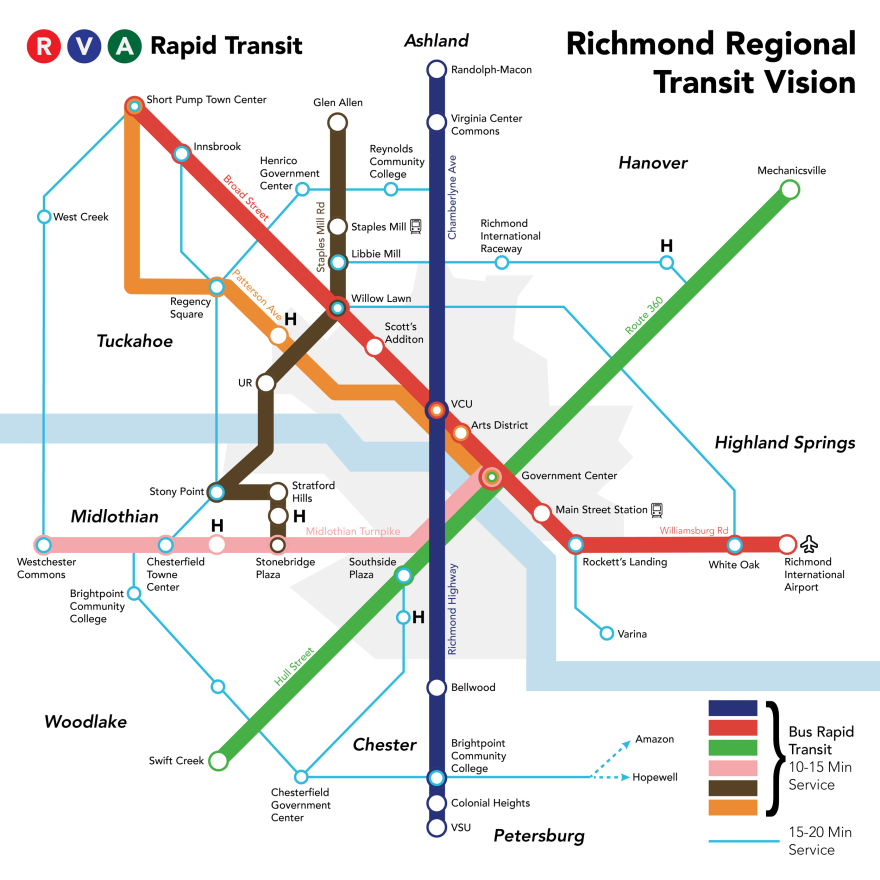Funding to increase the reach of bus routes and improve the frequency of travel time in the Richmond region needs a push — a big one. That's according to RVA Rapid Transit, an advocacy group that seeks to improve Richmond’s public transit system.
The group’s website states that it’s independently funded and not part of the Greater Richmond Transit Company or part of any municipal government. The nonprofit group recently released its State of Transit report for 2023.
“I can't say that we are better than we were,” said Faith Walker, executive director of RVA Rapid Transit. “I mean, we're moving at a snail's pace. In order for us to reach the goals of 2040, we're gonna have to invest more money into transit.”
Those 2040 goals include having multiple Pulse lines — aka GRTC Bus Rapid Transit — that run from Petersburg to Ashland, Mechanicsville to Swift Creek in Chesterfield County and downtown Richmond to Westchester Commons in Chesterfield.
Those goals also look to improve bus frequency.
“In 2017, the nine regions voted by 2040 to have all of those corridors to have 10- to 15-minute service,” Walker said. “2040 is in 17 years. And so, the reason why we started making the state of transit report is to remind our jurisdictions that we voted on making sure that this service is reliable and frequent by 2040.”
The report, which reads like an easily digestible pamphlet, lays out how Richmond was at the forefront of public transportation back in 1888, when the city launched the world’s first electric streetcar system — which ran until it was burned down in 1949.
1. Add more 'dignified' places to wait
But before the region can get back to being an updated, successful transportation beacon, there are a ton of hurdles to overcome in building up infrastructure to support more riders. This includes making sure all bus stops have benches and shelters.
The report states that out of 1,600 GRTC bus stops, only 26% (416) have benches and shelters.
“Going to work every day is dignified,” said Walker, who added that 50% of the riders make less than $25,000 a year. “These are the folks who are running our city, and they're working full time. These are hardworking people.”
She said having dignified places for people to wait for a bus is important.
“So, shelters, benches, to protect them from the heat, the weather, and these operate as cool zones through the city too,” Walker said.
Though Walker said GRTC is committed to increasing that 26% of coverage to 75% by 2027, the red tape involved needs to be streamlined. And that can take a long time depending on where the shelter is.
Right now, Walker said it takes anywhere from 30 to 60 months to install a bus shelter, and she said that’s on the shorter end of things. “A bus shelter can start from $5,000 — to all the way to $30,000 to $200,000. It just depends on where it is.”
Part of the delay depends on the existing infrastructure where a potential shelter would be built.
“It's either private property or government property,” Walker said. “VDOT sort of owns and controls those roads. And so, you would have to go through different state agencies to get shelters approved, this approval process is holding up the process.”
Another hurdle to overcome is to reverse the bus driver shortage.
“[GRTC’s] made a 40% increase in their operator pay, which is huge,” Walker said, adding that the pay increases should keep going up. “We just need to continue to elevate this role. Because what's happening is folks are able to find higher-paying jobs with the CDL.”
According to Walker, bus drivers need to be respected on the same level as police officers and teachers, who often get public-sector discounts and incentives when doing things like buying a home.
“We need to start implementing incentives as a community for operators so that work-life balance outside is elevated,” she said. “The respect of an operator needs to come back.”

2. Zero fare needs to continue — forever
The 2023 State of Transit report also calls for GRTC’s current zero fare policy to become permanent — something Walker said will help essential workers who rely on the bus and get more people out of cars.
GRTC implemented zero fare for all buses and CARE vans early on in the COVID-19 pandemic. It announced in late 2022 that the program would continue through at least June 2024.
“Why can’t we come together as a region and pay for fares when it's getting people out of their cars,” Walker said. “It's solving an economic crisis when it comes to higher rents and higher food prices. We are supporting a demographic of people who are hardworking, who are keeping our city alive. And majority of them are Black females. “
Walker said she hoped Richmond will one day get back to being a leader in transportation: “We're a capital city, we were the first to have the streetcar. We were leading transportation at one point.”



